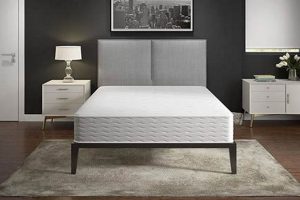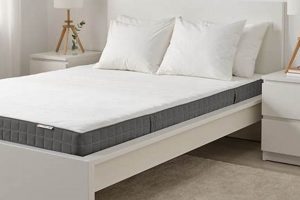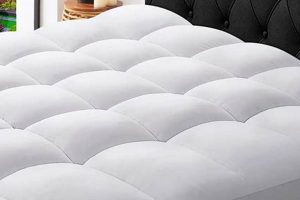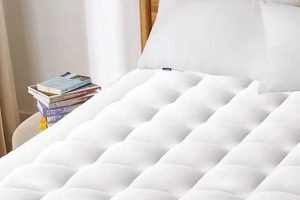The suitability of a sleep surface is significantly influenced by an individual’s preferred sleeping posture. A surface that optimally supports the body’s contours and minimizes pressure points is crucial for restorative sleep. Different sleeping positions, such as lying on the side or stomach, necessitate varying degrees of support and firmness to maintain spinal alignment and prevent discomfort. A mattress designed to accommodate both side and stomach sleeping styles must strike a balance between cushioning and firmness.
Selecting an appropriate sleep surface can profoundly affect sleep quality and overall well-being. Proper spinal alignment during sleep minimizes muscle strain, reduces the risk of back pain, and promotes healthy circulation. Historically, advancements in mattress technology have focused on addressing the diverse needs of different sleep positions, leading to specialized designs that cater to various body types and preferences. The benefits extend beyond comfort, contributing to improved physical health and cognitive function.
The subsequent sections will delve into the specific characteristics of mattresses suited for individuals who alternate between side and stomach sleeping positions. Factors such as material composition, construction techniques, and firmness levels will be examined to provide a comprehensive guide for informed decision-making. This analysis will equip readers with the knowledge to select a mattress that optimizes their sleep experience and promotes long-term health.
Selecting a Suitable Sleep Surface
Choosing an appropriate mattress necessitates careful consideration of individual sleep preferences and physical needs. The following guidelines provide insights into selecting a mattress conducive to both side and stomach sleeping positions.
Tip 1: Evaluate Firmness Level: A medium-firm mattress generally offers a suitable compromise. It provides sufficient cushioning for side sleeping while preventing excessive sinkage that can occur when stomach sleeping, which can misalign the spine.
Tip 2: Consider Material Composition: Memory foam, latex, and hybrid mattresses are often recommended. Memory foam contours to the body, alleviating pressure points. Latex provides responsiveness and support. Hybrid mattresses combine the benefits of both, incorporating innerspring coils for additional support.
Tip 3: Prioritize Spinal Alignment: The selected mattress should maintain the natural curvature of the spine, regardless of sleeping position. Incorrect alignment can contribute to back pain and discomfort.
Tip 4: Account for Body Weight: Individuals with higher body weight may require a firmer mattress for adequate support. Conversely, lighter individuals may prefer a softer surface to avoid excessive pressure.
Tip 5: Assess Edge Support: Strong edge support is beneficial, particularly for side sleepers who may utilize the entire mattress surface. It prevents rolling off the bed and provides stability when sitting on the edge.
Tip 6: Review Trial Periods and Warranties: Many manufacturers offer trial periods, allowing consumers to test the mattress before committing to a purchase. Additionally, comprehensive warranties provide protection against defects.
Tip 7: Investigate Layer Construction: A mattress with multiple layers, including a comfort layer and a support core, can offer enhanced pressure relief and spinal support. The comfort layer should conform to the body, while the support core provides stability and prevents sagging.
Adhering to these recommendations facilitates the selection of a mattress that promotes restful sleep and minimizes discomfort associated with alternating between side and stomach sleeping positions. Proper selection supports overall physical well-being.
The subsequent section will explore specific mattress models and brands that align with the aforementioned criteria, providing a more detailed evaluation of available options.
1. Firmness Level
Firmness level, in the context of a sleep surface, refers to the degree of resistance the mattress offers to compression. Its significance is amplified for individuals who alternate between side and stomach sleeping positions. Insufficient firmness can lead to spinal misalignment when stomach sleeping, resulting in lower back pain. Conversely, excessive firmness may create pressure points in the shoulders and hips when side sleeping, causing discomfort and disrupted sleep.
The ideal firmness level for such individuals is typically medium-firm. This configuration provides adequate support to prevent excessive sinking in the abdominal region during stomach sleeping, thereby maintaining spinal alignment. Simultaneously, it offers sufficient cushioning to alleviate pressure on the shoulders and hips when side sleeping. As an example, a mattress with a rating of 5-7 on a 1-10 firmness scale (where 1 is very soft and 10 is very firm) often achieves this balance. The effectiveness of a particular firmness level is also contingent on body weight; heavier individuals may require a slightly firmer mattress.
Understanding the relationship between firmness level and sleep position is essential for selecting a mattress that promotes restorative sleep and minimizes musculoskeletal discomfort. Challenges remain in precisely quantifying the optimal firmness due to individual variations in body type and personal preference. Despite these challenges, prioritizing a medium-firm mattress represents a pragmatic approach for those who frequently shift between side and stomach sleeping positions, aligning with the overarching goal of selecting a sleep surface designed to support diverse sleeping styles.
2. Material Composition
Material composition is a crucial determinant in the suitability of a mattress for individuals who sleep on both their side and stomach. The materials used directly influence the mattress’s ability to provide adequate support and pressure relief in these disparate sleeping positions. A mattress designed for side sleeping typically requires materials that conform to the body’s contours, alleviating pressure points on the shoulders and hips. Conversely, a mattress intended for stomach sleeping necessitates firmer materials to prevent excessive sinking in the midsection, which can lead to spinal misalignment. Consequently, a “best mattress for side and stomach sleepers” often incorporates a combination of materials designed to address both requirements.
For instance, hybrid mattresses combining innerspring coils with layers of memory foam or latex are frequently recommended. The innerspring coils provide the necessary support for stomach sleeping, preventing the spine from arching unnaturally. Simultaneously, the memory foam or latex layers offer contouring and pressure relief for side sleeping
. Another example is a mattress constructed with zoned support, where different areas of the mattress are designed with varying densities or firmness levels to accommodate different body regions and sleeping positions. This differentiated support can be achieved through varying coil gauges in an innerspring mattress or by utilizing different densities of foam within the comfort layers.
In summary, the material composition of a mattress significantly impacts its performance for individuals who alternate between side and stomach sleeping positions. The ideal composition balances support and pressure relief to maintain spinal alignment and minimize discomfort, regardless of the sleeping position. While specific material combinations may vary based on individual preferences and body types, understanding the role of each material is essential for selecting a mattress that promotes restful sleep and minimizes the risk of musculoskeletal issues. Further research into specialized foam formulations and coil designs may yield mattresses that more effectively cater to the needs of combination sleepers; however, the current market offers viable solutions through hybrid and zoned support designs.
3. Spinal Alignment
Spinal alignment is a core component of what constitutes an appropriate sleep surface, particularly for those who alternate between side and stomach sleeping positions. Misalignment of the spine during sleep can lead to a cascade of adverse effects, including chronic back pain, muscle stiffness, and nerve compression. A mattress that fails to maintain the natural curvature of the spine exacerbates these issues, regardless of the individual’s preferred sleep posture. Thus, the ‘best mattress’ for such individuals is, by definition, one that prioritizes and facilitates proper spinal alignment. For example, when a stomach sleeper’s hips sink excessively into a soft mattress, the spine arches unnaturally, creating stress on the lumbar region. Conversely, a side sleeper on a too-firm mattress may experience pressure point build-up at the shoulders and hips, pulling the spine out of alignment. The practical significance of selecting a mattress that supports spinal alignment extends beyond immediate comfort; it contributes to long-term musculoskeletal health.
To illustrate, consider the case of an individual with scoliosis who sleeps primarily on their side. A mattress with inadequate support will allow the spine to curve further, intensifying pain and discomfort. In contrast, a mattress with zoned support, where the lumbar region receives enhanced reinforcement, can help to maintain a more neutral spinal position, mitigating the effects of the scoliosis. Furthermore, the material composition of the mattress plays a critical role. Memory foam, for instance, conforms to the body’s contours, distributing weight evenly and reducing pressure points. However, if the memory foam layer is too thick or too soft, it may lack the necessary support to prevent sinking, thereby compromising spinal alignment. Therefore, the optimal mattress incorporates a balance of conforming materials and robust support structures to address the varying needs of both side and stomach sleepers.
In conclusion, the connection between spinal alignment and the selection of a mattress suited for both side and stomach sleepers is undeniable. A mattress that fails to uphold proper spinal alignment can lead to a range of negative health outcomes, underscoring the importance of careful consideration during the selection process. The challenge lies in finding a mattress that accommodates the diverse needs of these sleeping positions without compromising spinal integrity. Despite the complexities involved, prioritizing spinal alignment remains the paramount criterion when evaluating the suitability of a sleep surface, influencing long-term health and well-being. Subsequent discussions should delve into the specific mattress characteristics that best promote spinal alignment in combination sleepers.
4. Edge Support
Edge support, a critical feature in mattress construction, plays a significant role in the overall performance and suitability of a sleep surface, particularly for individuals who alternate between side and stomach sleeping positions. Its presence or absence directly impacts usable surface area, stability, and ease of movement, influencing sleep quality and comfort. Adequate edge support prevents sagging and provides a consistent level of support across the entire mattress, enhancing its long-term durability and suitability for diverse sleep needs.
- Usable Sleep Surface
Strong edge support maximizes the usable sleep surface area. Without it, the perimeter of the mattress compresses easily, making it feel smaller and less stable. For individuals sharing a bed or those who tend to move close to the edge, robust edge support prevents the sensation of rolling off, ensuring a secure and comfortable sleep experience. This is especially important for stomach sleepers who may spread out more than side sleepers.
- Ease of Entry and Exit
Effective edge support facilitates easier entry and exit from the bed. A firm edge provides a stable surface to sit on, aiding individuals with mobility limitations or those who prefer to sit on the edge of the bed while dressing or performing other tasks. The presence of strong edge support reduces strain and provides a secure point of contact, enhancing overall convenience and accessibility.
- Structural Integrity and Longevity
Solid edge support contributes to the structural integrity and longevity of the mattress. By preventing the edges from collapsing or sagging over time, it maintains the mattress’s shape and support characteristics. This is particularly important for heavier individuals or those who regularly sit on the edge of the bed. The long-term durability provided by adequate edge support translates into a more cost-effective investment.
- Motion Isolation
While not its primary function, edge support can indirectly contribute to motion isolation. A well-constructed edge can help dampen the transfer of motion across the mattress surface, reducing disturbances caused by a partner’s movements. This is beneficial for side sleepers sharing a bed, as it minimizes interruptions from a partner repositioning or getting in and out of bed. Although specialized motion isolation technologies are more effective, edge support provides an additional layer of stability.
The interrelation between edge support and its impact on usable surface area, ease of entry/exit, structural integrity, and even motion isolation underscores its relevance in the context of selecting the most appropriate mattress. Individuals seeking a mattress that accommodates both side and stomach sleeping positions should prioritize models with reinforced edges to ensure optimal comfort, stability, and long-term performance. Furthermore, the design of the edge support system, whether it involves reinforced coils, high-density foam encasements, or other innovative technologies, should be carefully considered to determine its effectiveness and durability.
5. Pressure Relief
Pressure relief, in the context of mattress design, refers to
the ability of a sleep surface to minimize concentrated force on specific areas of the body. For individuals who alternate between side and stomach sleeping positions, effective pressure relief is paramount for preventing discomfort and promoting restful sleep. The skeletal structure and weight distribution differ significantly between these two positions, creating varying pressure points. Side sleeping concentrates pressure on the shoulders and hips, while stomach sleeping, though less likely to cause concentrated pressure points, can create tension in the neck and lumbar region if the spine is not properly aligned. Consequently, a mattress designed for both positions must adeptly distribute weight and contour to the body to mitigate these potential issues. A real-world example is a mattress that uses a combination of memory foam and latex; the memory foam conforms to the body’s shape, distributing weight and reducing pressure on bony prominences, while the latex provides support to prevent excessive sinking, which could compromise spinal alignment. The practical significance of this understanding lies in the reduction of pain, improved sleep quality, and potential prevention of chronic musculoskeletal problems.
The materials used in the construction of a mattress directly impact its pressure-relieving capabilities. Memory foam, known for its viscoelastic properties, excels at conforming to the body’s shape, distributing weight, and minimizing pressure points. Latex, both natural and synthetic, offers a balance of support and contouring, providing pressure relief while maintaining a degree of responsiveness. Innerspring mattresses, particularly those with individually wrapped coils, can also offer localized pressure relief by conforming to the body’s contours and reducing motion transfer. However, the effectiveness of these materials in providing pressure relief is contingent on their density, thickness, and placement within the mattress layers. For instance, a mattress with a thin layer of low-density memory foam may not provide sufficient pressure relief for side sleepers, leading to discomfort and disrupted sleep. Conversely, a mattress with an excessively thick layer of memory foam may lack the necessary support for stomach sleepers, causing the hips to sink and the spine to misalign. The interplay between these materials determines the overall pressure-relieving performance of the mattress.
In conclusion, pressure relief is an indispensable attribute of any mattress designed to accommodate both side and stomach sleeping positions. The ability to minimize concentrated force on specific areas of the body promotes comfort, reduces pain, and supports spinal alignment. While the selection of materials and construction techniques plays a critical role in achieving effective pressure relief, the optimal configuration is contingent on individual preferences, body weight, and sleeping habits. The challenge lies in finding a mattress that strikes a balance between conforming to the body’s shape and providing adequate support to maintain proper spinal alignment. Ultimately, a comprehensive understanding of pressure relief and its relationship to mattress design is essential for making an informed decision and selecting a sleep surface that promotes restful and restorative sleep.
6. Motion Isolation
Motion isolation, referring to a mattress’s ability to minimize the transfer of movement across its surface, presents a critical consideration for individuals sharing a bed, especially when one or both partners are side and/or stomach sleepers. The disparate sleeping positions and potential for frequent repositioning inherent in these styles can easily disrupt the sleep of a bed partner if the mattress lacks effective motion isolation capabilities.
- Material Composition and Dampening
The materials comprising the mattress core and comfort layers significantly impact motion isolation. Memory foam and latex, for example, possess inherent dampening properties that absorb movement at the point of impact, preventing it from radiating across the mattress. Mattresses with interconnected innerspring systems, conversely, tend to exhibit higher motion transfer due to the interconnected nature of the coils. The effectiveness of motion isolation, therefore, is directly linked to the material’s ability to absorb and dissipate kinetic energy.
- Construction Techniques and Layering
Construction techniques employed in mattress manufacturing further influence motion isolation. Individually wrapped coils, also known as pocketed coils, allow each spring to move independently, minimizing the transmission of movement. Layering different materials, such as combining a high-density foam base with a memory foam comfort layer, can also enhance motion isolation by providing both support and dampening. The arrangement and density of these layers collectively contribute to the mattress’s capacity to absorb and isolate movement.
- Sleeping Position and Partner Disturbance
Side and stomach sleepers, due to their potential for more frequent shifting and repositioning throughout the night, can inadvertently disturb a bed partner if the mattress lacks adequate motion isolation. Side sleepers may toss and turn to alleviate pressure on their shoulders and hips, while stomach sleepers may adjust their position to maintain spinal alignment. A mattress with effective motion isolation minimizes the impact of these movements, allowing both partners to enjoy uninterrupted sleep.
- Testing and Subjective Perception
Motion isolation can be objectively measured through various testing methods, such as dropping a weighted object onto the mattress surface and measuring the resulting displacement at different points. However, the subjective perception of motion transfer can vary significantly among individuals. Factors such as body weight, sensitivity to movement, and sleeping habits can influence how readily a person detects motion. Therefore, while objective testing provides valuable data, the ultimate assessment of motion isolation effectiveness often relies on personal experience and preference.
In summary, motion isolation represents a crucial factor in selecting a mattress suitable for both side and stomach sleepers, particularly when sharing a bed. Material composition, construction techniques, sleeping positions, and individual perception all contribute to the overall effectiveness of motion isolation. A mattress that successfully minimizes motion transfer can significantly enhance sleep quality and reduce the likelihood of disturbances between bed partners.
Frequently Asked Questions
The following section addresses common inquiries regarding mattress selection for individuals who alternate between side and stomach sleeping positions. The information provided aims to clarify key considerations and guide informed decision-making.
Question 1: What firmness level is generally recommended for those who sleep on both their side and stomach?
A medium-firm mattress is typically recommended. This firmness level offers a balance of support for stomach sleeping and cushioning for side sleeping, promoting spinal alignment in both positions.
Question 2: Which mattress materials are most suitable for combination side and stomach sleepers?
Memory foam, latex, and hybrid mattresses are often cited as suitable choices. Memory foam contours to the body, alleviating pressure points. Latex provides responsiveness and support. Hybrid mattresses combine the benefits of both.
Question 3: How critical is spinal alignment when
selecting a mattress for these sleep positions?
Maintaining spinal alignment is paramount. The mattress should support the natural curvature of the spine in both side and stomach sleeping positions to minimize back pain and discomfort.
Question 4: Does body weight influence the selection of a mattress for combination sleepers?
Yes. Individuals with higher body weight may require a firmer mattress for adequate support. Lighter individuals may prefer a slightly softer surface to avoid excessive pressure.
Question 5: Why is edge support an important consideration?
Strong edge support is beneficial, particularly for side sleepers who may utilize the entire mattress surface. It prevents rolling off the bed and provides stability when sitting on the edge.
Question 6: Are trial periods and warranties essential when purchasing a mattress?
Trial periods allow consumers to test the mattress before committing to a purchase. Comprehensive warranties provide protection against defects, offering peace of mind and long-term value.
The selection of an appropriate mattress for combination side and stomach sleepers requires careful consideration of firmness, material, spinal alignment, and individual body characteristics. Prioritizing these factors can significantly improve sleep quality and overall well-being.
The subsequent section will offer actionable steps that the reader can employ in their pursuit of finding their perfect mattress.
Concluding Remarks
The preceding analysis has illuminated the multifaceted considerations involved in selecting a sleep surface that adequately accommodates both side and stomach sleeping positions. The discussion underscored the importance of firmness level, material composition, spinal alignment, edge support, pressure relief, and motion isolation as crucial factors influencing sleep quality and musculoskeletal health. An ideal solution involves a balance of support and contouring, addressing the distinct needs of each sleeping posture to mitigate potential discomfort and promote long-term well-being.
The pursuit of an optimal sleep experience necessitates careful evaluation and informed decision-making. Individuals are encouraged to leverage the insights provided to assess their unique needs and preferences, ultimately selecting a mattress that fosters restorative sleep and supports overall physical health. The investment in a properly designed sleep surface constitutes a significant contribution to long-term well-being and daily functionality.




![Top Rated Best Mattress For Night Sweats - [Brand Name] Organic & Natural Mattress Buyer’s Guide: Non-Toxic Sleep Solutions Top Rated Best Mattress For Night Sweats - [Brand Name] | Organic & Natural Mattress Buyer’s Guide: Non-Toxic Sleep Solutions](https://mattressworldpa.com/wp-content/uploads/2025/07/th-7601-300x200.jpg)

![Top-Rated Best Mattress for Adjustable Base Frames [Guide] Organic & Natural Mattress Buyer’s Guide: Non-Toxic Sleep Solutions Top-Rated Best Mattress for Adjustable Base Frames [Guide] | Organic & Natural Mattress Buyer’s Guide: Non-Toxic Sleep Solutions](https://mattressworldpa.com/wp-content/uploads/2025/07/th-7599-300x200.jpg)
